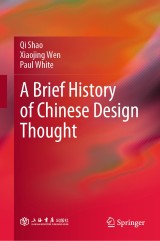Details

A Brief History of Chinese Design Thought
|
53,49 € |
|
| Verlag: | Springer |
| Format: | |
| Veröffentl.: | 05.10.2022 |
| ISBN/EAN: | 9789811694080 |
| Sprache: | englisch |
| Anzahl Seiten: | 280 |
Dieses eBook enthält ein Wasserzeichen.
Beschreibungen
<div>This book introduces readers to the history of design thinking in pre-modern China. The content is structured according to successive dynasties, covering the seven major periods of the pre-Qin, Qin and Han, Wei and Jin, Sui and Tang, Song and Yuan, Ming, and Qing dynasties. Each chapter introduces the most representative individuals of the period and discusses their work and ideas in order to reveal the national and cultural features of the respective periods. A distinctive feature of cultural identity running through the long course of China’s historical development is the argument that actions are determined by ideas: Such a view can be found in long-standing thinking on art, design, and creativity. The book demonstrates that conscious design is the vital link between the ideas that constitute human cultures and the physical objects that make up their resulting material cultures. It is the attribute of design that defines what it is to be human and also produces the physical evidence of the evolution of Chinese civilization. The book reveals the integrated characteristics of Chinese culture and art and shows how both changing and recurring ideologies have influenced Chinese design practice since the ancient Shang and Zhou dynasties and how these forces have shaped the spirit and materiality of Chinese civilization. Design is the cornerstone that has made China one of the major contributors to human civilization throughout the thousands of years of its history.</div><div><br></div><div>Given its focus, the book largely appeals to two main audiences: an academic readership of students and researchers interested in cultural studies and, a more general one, consisting of those interested in international comparisons and wishing to learn more about Chinese history, society, and culture. In order to appeal to both, the book is written in a clear and accessible language.</div><div><br></div>
Design Thoughts in the Pre-Qin Dynasty.- Design Thoughts in the Qin and Han Dynasties.- Design Thoughts in the Wei and Jin Dynasties.- Design Thoughts in the Sui and Tang Dynasties.- Design Thoughts in the Song and Yuan Dynasties.- Design Thoughts in the Ming Dynasty.- Design Thoughts in the Qing Dynasty.
<div>Shao Qi is Professor of Shanghai Normal University. His research focuses on Chinese art history and painting theories, especially on Ming and Qing dynasty landscape painting.</div><div><br></div><div>Xiaojing (Rachael) Wen, Ph.D., is Assistant Professor, School of Design, Shanghai JiaoTong University, China, and Visiting Scholar, Department of Geography, University of Sheffield, UK. Her research covers design history and cultural comparisons, particularly focusing on the comparative study of Chinese and Western design thinking.</div><div><br></div><div>Paul White, D.Phil., is Emeritus Professor of Geography and Former Deputy Vice-Chancellor, University of Sheffield, UK. His research covers the comparative study of social, cultural, and demographic structures, with a particular focus on Europe and on influences originating in other parts of the world.</div>
<div>This book introduces readers to the history of design thinking in pre-modern China. The content is structured according to successive dynasties, covering the seven major periods of the pre-Qin, Qin and Han, Wei and Jin, Sui and Tang, Song and Yuan, Ming, and Qing dynasties. Each chapter introduces the most representative individuals of the period and discusses their work and ideas in order to reveal the national and cultural features of the respective periods. A distinctive feature of cultural identity running through the long course of China’s historical development is the argument that actions are determined by ideas: Such a view can be found in long-standing thinking on art, design, and creativity. The book demonstrates that conscious design is the vital link between the ideas that constitute human cultures and the physical objects that make up their resulting material cultures. It is the attribute of design that defines what it is to be human and also produces the physical evidence of the evolution of Chinese civilization. The book reveals the integrated characteristics of Chinese culture and art and shows how both changing and recurring ideologies have influenced Chinese design practice since the ancient Shang and Zhou dynasties and how these forces have shaped the spirit and materiality of Chinese civilization. Design is the cornerstone that has made China one of the major contributors to human civilization throughout the thousands of years of its history.</div><div><br></div><div>Given its focus, the book largely appeals to two main audiences: an academic readership of students and researchers interested in cultural studies and, a more general one, consisting of those interested in international comparisons and wishing to learn more about Chinese history, society, and culture. In order to appeal to both, the book is written in a clear and accessible language.</div>
Reveals the cultural ideas and intentions behind Chinese creativity and design Provides detailed discussions of the ideologies of design in China Offers readers a deeper understanding of the evolution of Chinese civilization

















